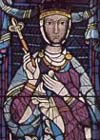Ermesinda of Luxembourg
| Ermesinde, Countess of Luxembourg | |
|---|---|

Ermesinde, Countess of Luxembourg
|
|
| Spouse(s) |
Theobald I of Bar Waleran III of Limburg |
| Noble family | Namur |
| Father | Henry IV of Luxembourg |
| Mother | Agnes of Guelders |
| Born | July 1186 |
| Died | 12 February 1247 (aged 60–61) |
Ermesinde (1186 – 12 February 1247), Countess of Luxembourg, reigned between 1197 and 1247. She was the only child of Count Henry IV and his second wife, Agnes of Guelders.
Prior to her birth, her aging father Henry had recognized his nephew, Count Baldwin V of Hainaut, as his heir presumptive. However, the 72-year-old count fathered a daughter, Ermesinde, who displaced Baldwin as heir presumptive.
Upon Henry's death in 1197, a war of succession inevitably took place. At its end, it was decided that Count Henry's fiefs would be split: Baldwin would have Namur, Ermesinde would have Durbuy and La Roche, and Luxembourg would revert to their common liege, the Holy Roman Emperor. Emperor Henry VI then gave the fief to his brother Otto.
Ermesinde was initially betrothed to Henry II of Champagne, but the engagement was cancelled in 1189. Instead her first husband was Theobald I of Bar (1158–1214). He successfully negotiated with Philip of Namur and his brother Baldwin for renunciation of Luxembourg, thus making Theobald and Ermesinde the Count and Countess of Luxembourg.
When Theobald died in 1214, Ermesinde married Waleran III, Count of Limburg (1180–1226), who would rule as the Count of Luxembourg. In 1223 Ermesinde and Waleran pressed their claim to Namur against Margrave Philip II, but were ultimately unsuccessful.
After Waleran's death, Ermesinde ruled Luxembourg alone for two decades. She proved to be an effective administrator, granting charters of freedom to several towns and increasing the prosperity of her country.
Legend has it that the Countess was one day walking in the area around her castle, near Eischen. There she saw a woman coming down from a hill, who had in her arms a child that was wrapped in sheepskin, on which was a black cross.
...
Wikipedia
